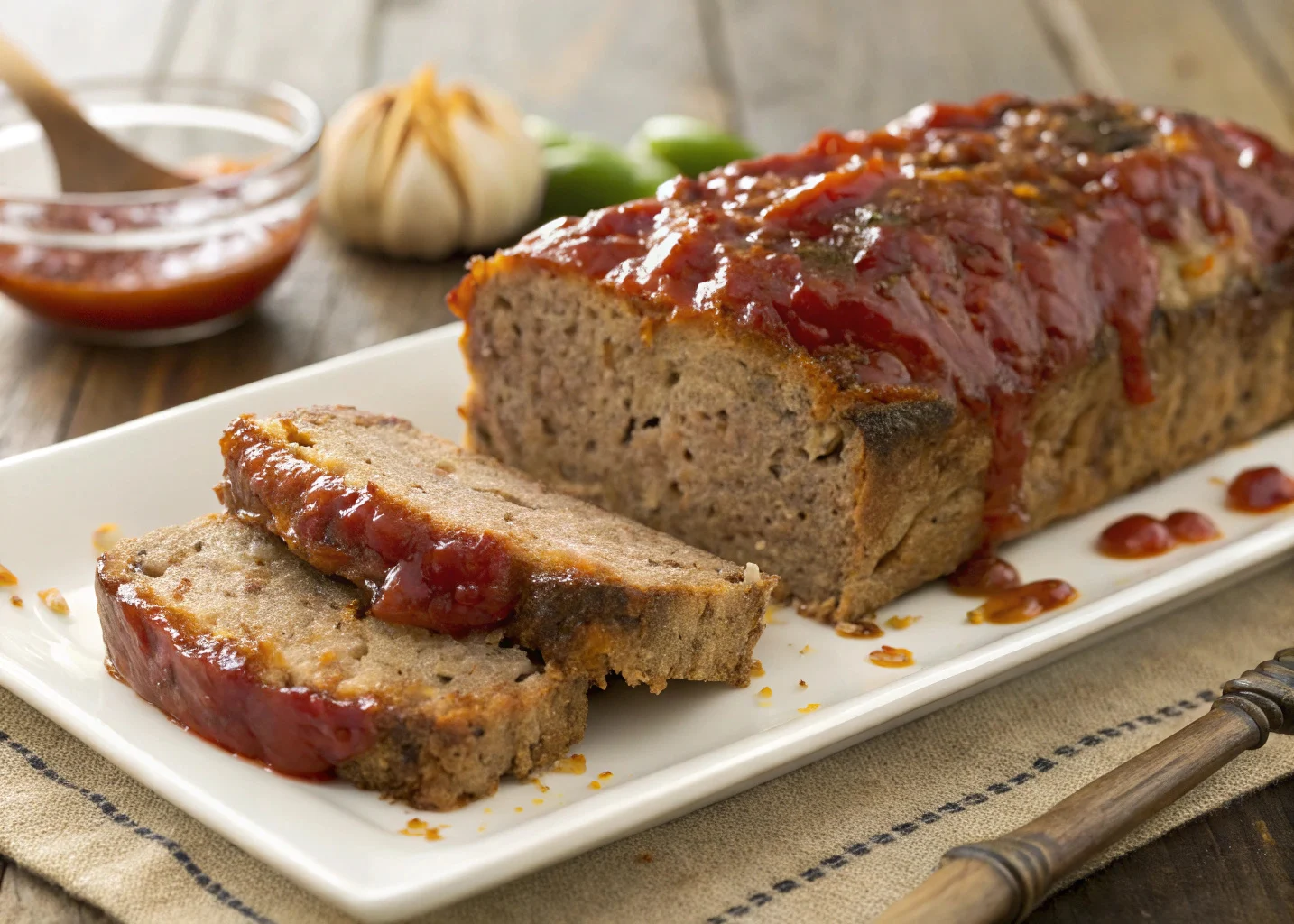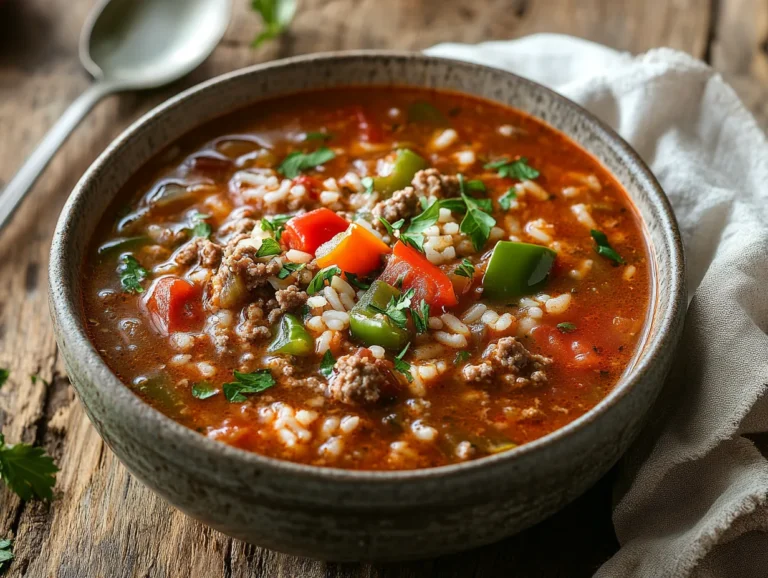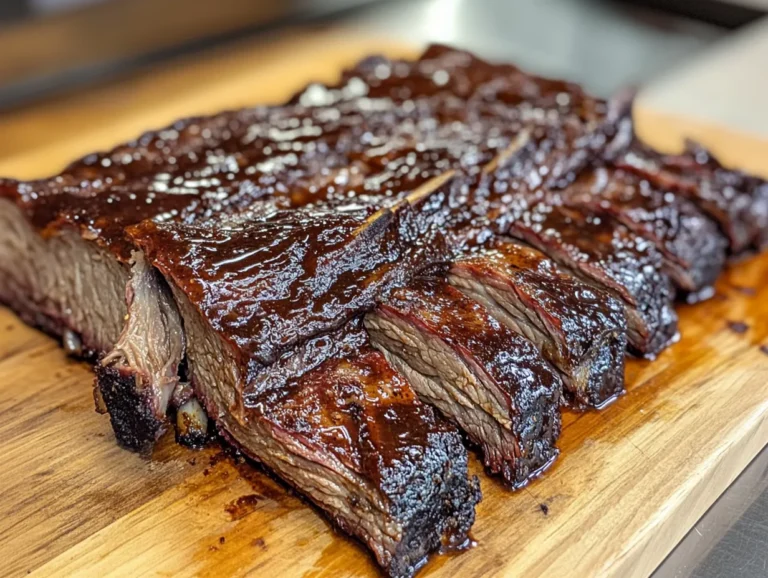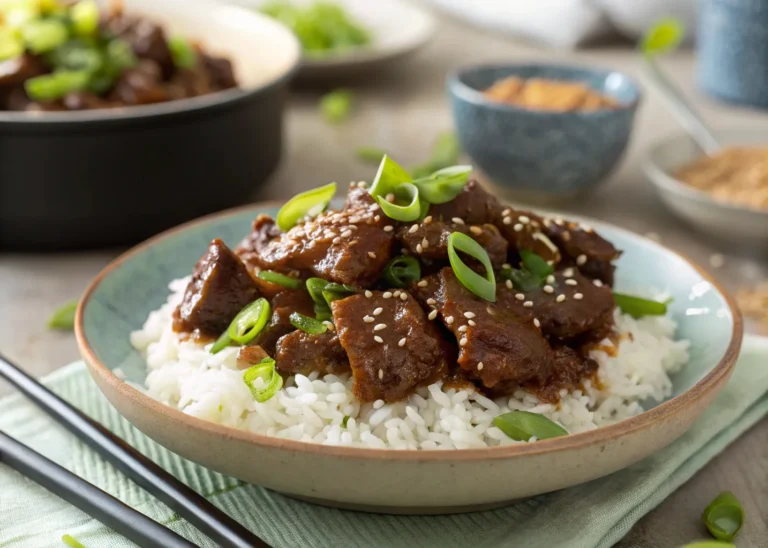If you’re searching for a foolproof, flavorful, and easy dinner that brings everyone to the table, Lipton Onion Soup Meatloaf is exactly what you need. This classic meatloaf recipe has stood the test of time thanks to its unbeatable combination of savory seasoning and simple prep. Using the famous Lipton Onion Soup Mix as the secret flavor booster, this dish transforms everyday ground beef into a hearty, mouthwatering meal that’s perfect for busy weeknights or weekend comfort food.
In this complete guide, we’ll walk you through every step of making the best onion soup meatloaf, from the ingredients to the baking tips. Whether it’s your first time or you’re perfecting your go-to dinner recipe, we’ve got you covered with smart tips, storage advice, and delicious variations. Let’s dive into why this dish deserves a permanent spot in your dinner rotation.
Why Lipton Onion Soup Meatloaf is a Timeless Classic
What Makes Lipton Onion Soup Mix So Special?
The real magic behind this meatloaf recipe comes from Lipton Onion Soup Mix. It’s a pantry staple that packs a bold onion flavor with a perfect blend of herbs and spices—all in one convenient envelope. You don’t need to dice fresh onions or guess your seasoning. The mix does the heavy lifting, giving the meatloaf that rich, savory base without overcomplicating the prep.
What sets it apart is how it naturally binds the meat with moisture and flavor. Unlike other recipes that may turn out bland or dry, the soup mix locks in taste and keeps each slice juicy. It also eliminates the guesswork, making it ideal for new cooks and seasoned pros alike.
How the Recipe Became a Comfort Food Staple
Lipton Onion Soup Meatloaf has been around for decades, and its popularity hasn’t faded. It’s one of those comforting meals that families pass down through generations. Why? Because it’s easy to make, affordable, and hits all the right notes of home-cooked goodness.
This recipe isn’t trendy—it’s timeless. It’s not trying to reinvent dinner. It’s keeping things simple, hearty, and satisfying. That’s why you’ll find it on weeknight tables, in meal preppers’ kitchens, and even featured in family gatherings.
Ingredients You Need for the Perfect Onion Soup Meatloaf

Core Ingredients for Flavorful Results
You don’t need a mile-long grocery list to make a meatloaf that’s full of flavor. Here’s what you really need:
| Ingredient | Purpose |
|---|---|
| Ground beef (lean) | Base of the meatloaf; offers structure and richness |
| Lipton Onion Soup Mix | Main flavor source; binds and seasons |
| Eggs | Bind the mixture together |
| Breadcrumbs | Absorb moisture; add texture |
| Water or broth | Keeps the meat moist |
| Ketchup (optional) | Adds a tangy finish when used as a topping |
This combination creates a classic, balanced taste profile: savory, tender, and just the right amount of bite.
Optional Add-Ins to Elevate Your Meatloaf
While the classic version is satisfying on its own, you can add a twist without messing with tradition. Try:
- Shredded carrots or zucchini for added moisture and nutrition
- Chopped fresh herbs like parsley for brightness
- A dash of garlic powder or black pepper for deeper seasoning
- Grated cheese inside or on top for richness
Keep it simple, or make it your own. The base recipe is forgiving and easy to customize.
How to Make Lipton Onion Soup Meatloaf Step-by-Step
Prepping the Meatloaf Mixture
- Preheat your oven to 350°F (175°C).
- In a large bowl, combine the ground beef, Lipton Onion Soup Mix, eggs, and breadcrumbs. Mix gently but thoroughly.
- Slowly pour in the water or broth while mixing, just enough to bind the ingredients. The mixture should be slightly moist but still hold its shape without falling apart.
- If using optional veggies or cheese, fold them in gently at this stage.

Shaping, Baking, and Resting Tips for Best Texture
- Shape the meat mixture into a loaf and place it on a baking sheet lined with parchment or foil. You can also use a loaf pan for more structured edges.
- For extra flavor, spread a thin layer of ketchup on top before baking.
- Bake uncovered for about 55 to 65 minutes, or until the internal temperature reaches 160°F.
- Once out of the oven, let it rest for 10 minutes before slicing. This step is crucial—it helps the juices redistribute and prevents a crumbly texture.
This method keeps the meatloaf tender on the inside with a slightly crisp, flavorful outer layer. Slice it thick, serve it hot, and enjoy the best version of a classic meal.
Cooking Tips for Juicy, Flavorful Meatloaf
Temperature and Timing Guidelines
One of the most common issues with meatloaf is overcooking. When it’s baked too long, the texture turns dry and dense. On the other hand, undercooking it can be risky and unappetizing. The key? Use a meat thermometer.
- Bake at 350°F (175°C) — this is the ideal temperature that allows the meatloaf to cook evenly without drying out.
- Check for doneness at 55 minutes, but don’t go purely by time.
- Internal temperature should reach 160°F (71°C) to be fully cooked and safe to eat.
If you don’t have a thermometer, look for signs like bubbling juices at the base and a firm top crust. Still, a thermometer is your best friend for consistency.
How to Avoid Dry or Crumbly Loaf
Nobody wants dry meatloaf. Luckily, it’s easy to avoid with a few smart tricks:
- Don’t overmix the meat mixture — doing so breaks down the muscle fibers, making the loaf tough. Mix until just combined.
- Add enough moisture — using broth or water helps balance the breadcrumbs and keeps the texture light.
- Let it rest — after baking, give your meatloaf at least 10 minutes to rest. Cutting too soon releases the juices too fast and can dry out the meat.
Other quick tips:
- Use lean ground beef, but not extra-lean. A balance of 85/15 works best for moisture and shape.
- Avoid packing the loaf too tightly. A looser form helps airflow and gives a better bite.
Side Dishes that Pair Perfectly with This Meatloaf
Classic Sides: Mashed Potatoes, Green Beans, and More
Lipton Onion Soup Meatloaf has that nostalgic, hearty flavor that pairs beautifully with traditional comfort food sides. Here are the classics that never disappoint:
| Side Dish | Why It Works |
|---|---|
| Mashed Potatoes | Creamy texture complements the savory meatloaf |
| Steamed Green Beans | Adds freshness and crunch |
| Roasted Carrots | Brings sweetness that balances the rich meat |
| Buttery Corn Kernels | Simple, sweet, and crowd-pleasing |
| Classic Dinner Rolls | Perfect for soaking up extra juices |
These sides round out the plate without overpowering the star of the meal. Serve with a spoonful of ketchup glaze or meatloaf gravy, and you’ve got a dinner everyone will remember.
Creative Ideas for Balanced Meals
Want to mix things up a bit? You can elevate your meatloaf meal with these fresh, modern side options:
- Cauliflower mash for a lighter low-carb alternative to potatoes
- Grilled asparagus or sautéed zucchini for a bright green touch
- Quinoa salad with lemon vinaigrette for something cool and tangy
- Sweet potato fries baked in the oven for a sweet-savory combo
Whether you’re sticking to tradition or adding a twist, the goal is balance—something crisp, something creamy, and something to mop up that delicious meatloaf flavor.
Leftover Lipton Onion Soup Meatloaf Ideas
How to Store and Reheat Without Drying Out
Leftovers from this meatloaf recipe are pure gold—if you store and reheat them right. Here’s how to keep the flavor and texture intact:
- Refrigerate properly: After the meatloaf has fully cooled, wrap slices tightly in foil or place them in an airtight container. It will keep well in the fridge for up to 4 days.
- Want to save some for later? Wrap each slice tightly in plastic wrap, then cover with foil. Freeze for up to 3 months, and don’t forget to label and date each one for easy grab-and-go meals.
- Reheat gently: Warm leftovers in a 300°F oven, wrapped in foil, for 15–20 minutes. For microwave reheating, cover the slice with a damp paper towel to maintain moisture and heat in 45-second intervals.
Avoid microwaving uncovered, which causes uneven heating and dry edges. A little extra broth or a spoonful of ketchup on top helps revive moisture, too.
Creative Ways to Use Leftovers (Sandwiches, Bowls, etc.)
Tired of the same ol’ slice on a plate? Let’s get creative with those leftovers:
- Meatloaf Sandwich: Slice it thick and add to toasted bread with mayo, lettuce, and pickles. Cold or hot—it’s unbeatable.
- Stuffed Bell Peppers: Crumble leftover meatloaf and mix it with cooked rice. Stuff into halved bell peppers and bake until heated through.
- Grain Bowls: Top a bowl of brown rice or quinoa with chopped meatloaf, roasted veggies, and a drizzle of your favorite dressing or sauce.
- Meatloaf Hash: Dice it up and toss with pan-fried potatoes, onions, and peppers for a hearty breakfast-for-dinner option.
For another slow-cooked classic, don’t miss these tender Beef Tips and Noodles in the Crock Pot. It’s a great addition to your weekly comfort food lineup.
With the right approach, leftovers become a whole new meal—quick, tasty, and satisfying.

Healthier Swaps for a Lighter Meatloaf
Lean Ground Beef Options and Low-Sodium Mixes
Watching your intake or simply want a lighter version of this classic? No problem—healthy tweaks are easy with this recipe.
- Go lean with your ground beef: Choose 90/10 or 93/7 ground beef for lower fat content. Just make sure to add a bit more moisture, like broth or grated veggies, to avoid dryness.
- Use a reduced-sodium Lipton Onion Soup Mix: If you’re watching salt, this is a simple switch that maintains flavor without going overboard.
- Watch the toppings: Instead of sugary ketchup glazes, try a simple tomato puree or Greek yogurt-based topping with a bit of garlic and herbs.
Try homemade beef bone broth as a healthy, flavor-rich alternative to water or canned broth. It adds depth and helps maintain moisture.
These adjustments can make your meatloaf feel lighter without sacrificing taste or texture.
Whole-Grain and Veggie-Based Substitutes
Boost the nutritional value even further with these smart swaps:
- Whole-wheat breadcrumbs: A fiber-rich alternative to traditional white crumbs.
- Rolled oats: Unsweetened, old-fashioned oats absorb moisture well and add heartiness.
- Shredded vegetables: Try grated zucchini, carrots, or even spinach mixed into the meat for added nutrients and moisture.
- Egg alternatives: Use flaxseed meal and water (1 tbsp flax + 3 tbsp water per egg) if you’re cutting back on cholesterol.
These ingredient swaps support a well-balanced diet while still delivering the rich, comforting flavor you expect from a homemade onion soup meatloaf.
Common Mistakes to Avoid When Making This Recipe
Overmixing or Underseasoning the Meat
One of the easiest ways to mess up an otherwise perfect meatloaf is by overworking the meat mixture. When you mix the ingredients too much, you break down the texture of the beef, leading to a dense, rubbery loaf.
Here’s how to avoid it:
- Use your hands or a fork and mix just until combined. The mixture should be cohesive but still soft.
- Let the ingredients sit for a few minutes before shaping. This allows the breadcrumbs to absorb moisture and bind the mixture naturally.
Also, don’t forget that Lipton Onion Soup Mix brings plenty of seasoning—but if you’ve added veggies or oats, you might need a pinch of extra salt or pepper to balance the flavors.
Using the Wrong Baking Dish or Pan Size
Shape matters more than most people think. Using a dish that’s too deep can cause the meatloaf to steam instead of bake, leaving it soggy in the center and overcooked on the edges.
Follow these tips:
- Use a shallow loaf pan or a baking sheet lined with foil to ensure even cooking and prevent soggy edges.
- Shape your meatloaf by hand into a freeform loaf, which allows air to circulate around it evenly.
- If you’re doubling the recipe, divide it into two smaller loaves rather than one giant one.
These small decisions make a big difference in the final texture and appearance of your meatloaf.
Frequently Asked Questions (FAQs) About Lipton Onion Soup Meatloaf
Can I use Lipton Onion Soup Mix in other recipes?
Yes! It’s versatile and works well in dips, burgers, casseroles, roasted potatoes, and even slow cooker meals. It adds savory flavor without much effort.
What can I substitute for Lipton Onion Soup Mix?
You can make your own blend using dried onion flakes, onion powder, garlic powder, beef bouillon granules, and parsley. However, it may not match the convenience and depth of the original mix.
What’s the best way to keep meatloaf from falling apart?
Use enough binding agents like eggs and breadcrumbs and avoid overcooking. Let the loaf rest before slicing so the juices redistribute and hold the shape.
What ground beef is best for meatloaf?
Go for 85/15 or 90/10 lean ground beef. It strikes the perfect balance between flavor and moisture. Too much fat can make the loaf greasy, while too little can make it dry.
Can I freeze Lipton Onion Soup Meatloaf?
Definitely—cooked meatloaf freezes beautifully for up to 3 months. Wrap individual slices for quick reheating, and thaw them in the fridge overnight before warming in the oven.
How long should I let meatloaf rest before serving?
Let it rest for 10 minutes after baking. This allows the juices to settle and makes slicing cleaner and easier.
Conclusion: A Comfort Classic You’ll Come Back to Again and Again
Lipton Onion Soup Meatloaf isn’t just another dinner recipe—it’s the kind of meal that brings comfort, convenience, and flavor to the table all in one. With only a few ingredients and a simple prep process, you can turn ordinary ground beef into something truly satisfying. Whether you’re cooking for family or prepping meals for the week, this recipe delivers consistency and taste every single time.
It’s budget-friendly. It’s kid-approved. It’s a true American classic with a bold onion twist.
Once you try it, you’ll know exactly why this humble meatloaf has earned its permanent spot in kitchens across the country.
Love hearty beef dinners? Try this Instant Pot Beef Stroganoff next—it’s just as comforting and even faster to make.
Don’t be surprised if it becomes one of your all-time favorites, too.
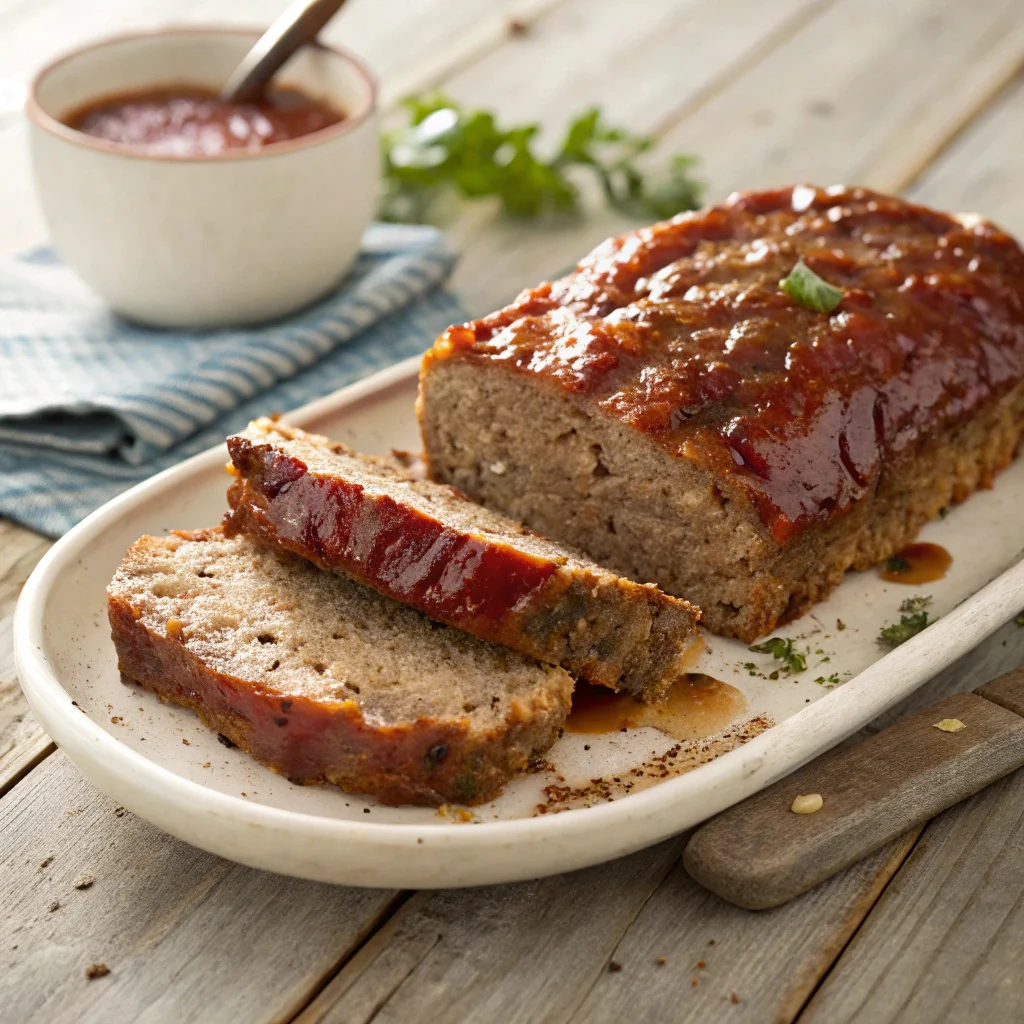
Lipton Onion Soup Meatloaf
Ingredients
Equipment
Method
- Preheat oven to 350°F (175°C).
- In a large bowl, combine ground beef, Lipton Onion Soup Mix, eggs, and breadcrumbs.
- Slowly add the water or broth while mixing. The mixture should be moist but firm.
- Shape into a loaf and place in a shallow loaf pan or on a foil-lined baking sheet.
- Spread ketchup on top if desired.
- Bake for 55–65 minutes or until internal temp reaches 160°F.
- Let rest for 10 minutes before slicing and serving.
Notes
- Avoid overmixing the meat mixture. Mix gently just until combined to keep the meatloaf tender.
- To check doneness, insert a meat thermometer into the center—your meatloaf is ready when it hits 160°F (71°C) internally.
- Let the meatloaf rest for at least 10 minutes before slicing. This keeps the juices inside and ensures cleaner cuts.
- Leftovers? Wrap individual slices in plastic wrap and foil, then freeze for up to 3 months. Thaw overnight and reheat in the oven for best texture.


